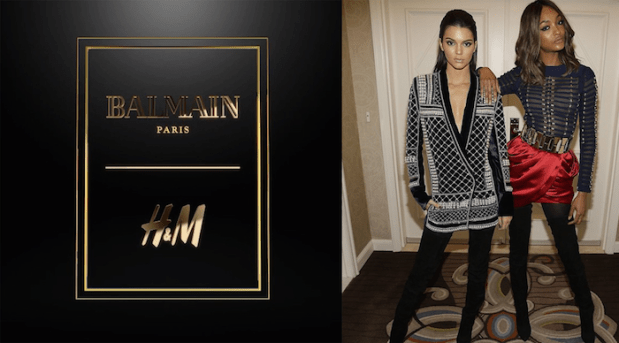Balmain, H&M And The Rise Of Fauxture

When 2015 comes to a close, Chinese cybercriminals will be saddened to learn that they have once again come in second place in the race to see who or what can break the Internet the maximum number of times in a single year. For yet another year, the Kardashian family will maintain their undisputed mastery of that domain.
Mastering the art of hacking is impressive, but the Kardashians as a genetic cohort share the sort of superpowers that the ancient Greeks commonly ascribed to sirens. And because this is the modern age, instead of luring sailors to their death, Kardashirens overawe servers with their tsunami of enthusiastic followers who want to be just like them.
Drowning in that enthusiasm this week was H&M’s website — though in this particular case, the torrent can more fairly be credited to a Kardashian assist as opposed to a direct assault, a la infamous photo spread for Paper.
The occasion that drove the crash was the launch of the Balmain x H&M line in stores and online this week — and that frenzy was of course far more than digital, selling out in locations all over the world in hours and in some cases minutes, drawn by a social media marketing campaign that had consumers practically frothing at the mouth by the time goods hit the shelves.
And while the Day 1 headlines are surely about success, we can’t help but wonder if an inspired sales move today might just be risky business in a digital world with a short attention span.
Feeling The Frenzy
As The New York Times reported, the collaboration between the heretofore obscure boutique French couture line and the fast fashion retailer that specializes in selling inexpensive, expendable, runway inspired <<cough>>ripped off <<cough>> apparel drew the eagerly awaiting in droves.
“I have traveled from Bulgaria, been here since 9 p.m. last night, and I just want a single piece — that jacket — my heart is set on it,” Darina Stefanova told The Times as she milled with the thousands who found themselves standing in the fall chill outside the brand’s flagship store in London.
 “But with the madness that’s started unfolding, I’m not sure I’ll get my wish. It’s the fault of these men. Things are starting to get dangerous,” she noted.
“But with the madness that’s started unfolding, I’m not sure I’ll get my wish. It’s the fault of these men. Things are starting to get dangerous,” she noted.
The men she referred to were a class of semi-professional goons — young men in their 20s who pushed and intimidated their way to the front of the line, where they managed to maintain a presence so menacing that the big opening of the collection was delayed until police could remove the street tough population.
“They are professional gangs, you know, and this is a strategy they have preplanned,” noted Ryan Fong, another dejected shopper in London. “I’ve seen it before, but never as bad as this. They get in first, buy up all the product, then flog it for five times the price on eBay. They are scary men, and I don’t want to get in their way.”
Eventually, however, the doors were opened, and London’s shoppers knew the unmitigated joy that was shopping for Balmain at an H&M. It was a joy that rather notably united people around the world, from Paris, where supplies were gone within three hours, to New York’s Time Square and Boston’s Newbury Street, where lines stretched for blocks as consumers waited overnight for their chance to carry the custom black shopping bag stamped with the golden Balmain x H&M branding.
It is not fashion for the faint of heart, nor clothing marketing to any traditional definition of the masses. The  severe lines, embellished shoulders, leather, big gold buttons, fur, feathers — all the general elements of the high drama couture house are on display for their H&M pair up. The clothes on display last week in the world’s fashion hubs looked like the creation of someone who spends their days binge watching “Mad Max” movies and old “Dynasty” episodes, their nights dancing at raves, and their mornings designing clothing based on the fever dreams they have in between.
severe lines, embellished shoulders, leather, big gold buttons, fur, feathers — all the general elements of the high drama couture house are on display for their H&M pair up. The clothes on display last week in the world’s fashion hubs looked like the creation of someone who spends their days binge watching “Mad Max” movies and old “Dynasty” episodes, their nights dancing at raves, and their mornings designing clothing based on the fever dreams they have in between.
In short, it looks like Balmain, but it’s not priced like it.
Which is not to say what was for sale at H&M this week was even remotely in line with the rest of the pricing in the store. The collection included a ~$650 long sleeve mini-dress that features 250K handsewn beads. And for the lads, a pricey red, leather and velvet jacket awaited. Certainly not cheap. But given the fact that buying straight from Balmain is almost certainly a $1,000 investment — for example, a pair of jeans that are literally described on their website as “destroyed” will currently run a consumer a little over $1,200 — it was a good deal for those who managed to snap up the merchandise. The deal will not be quite as good for the less fortunate shoppers who will be buying those clothes on eBay at 2X-5X the regular price.
Instagram For Experts
The credited mind behind the the Balmainia that broke out this week is that of Olivier Rousteing, creative director of the French fashion house. If that name and the fashion firm for whom he works was entirely unknown to you until this week, you are not as tragically unhip as you may fear.
Though the French house of haute couture has been around since 1946, it wasn’t until Rousteing joined the firm in 2009 that Balmain began showing up prominently in fashion magazines — and more importantly on the toned bodies of the frequently photographed like the Kardashian Klan, Amal Clooney, and Nicki Minaj, among others.
That powerful brand buzz turned quite smoothly into the highly effective social media marketing campaign that launched Balmain x H&M, which saw Rousteing (with is 1.6 million followers on Instagram) stir up a maelstrom of online interest, aided greatly by his socially enabled posse of highly visible supporters Kylie Jenner, Rihanna and Gigi Hadid.
The clothes made their first public appearances at the Billboard Music awards about three weeks ago, followed by a pop-up fashion show or two — and scores and scores of posts all over Twitter, Instagram, Facebook and anywhere else fashion fans could conceivably key in: #Balmainia.
“When we talk about the power of social media in commerce, I think what we saw this week all over the world with H&M is the clearest demonstration of the best use of its potential,” New York based retail analyst Claire Demot told PYMNTS. “We keep talking about how we’re going to put buy buttons everywhere — and could that be useful to some consumers? Sure, but that isn’t ever going to be where the real power in social media for brands is going to be.”
The power, she noted, is in the events as they unfolded around the Balmain launch at H&M, which allowed two brands — for very little investment in traditional marketing — to create near hysteria about products almost sight unseen.
“This isn’t just selling the Kardashian’s clothes. We’ve seen there is limited value in that type of endorsement, because, quite frankly, most people won’t look like Kim Kardashian in the clothes. But this kind of marketing drive is actually creating a virtualized Kardashian experience for customers.”
“Consumers aren’t just buying. All day, all over Instagram we see consumers logging their entire shopping journey, from camping out on the street to an entire photo shoot of all their clothes, and sending that out to their friends and followers.”
 Demot also noted that the sort of joint effort between brands could, if leveraged correctly, be the real future of experiential retail — and offer a roadmap of what those experiences should be.
Demot also noted that the sort of joint effort between brands could, if leveraged correctly, be the real future of experiential retail — and offer a roadmap of what those experiences should be.
But, she noted, doing it right is hard, particularly for the luxury retailer in the partnership.
Scarcity Is The Heart Of Luxury
The problem, with this kind of of promotion is diminishing returns. The rarity of having couture available at a relatively affordable price for consumers obviously had great power to pull consumers out of their day jobs and into lines.
“The more it happens, the less of an event it becomes and, more problematically, the less rarified and desirable the couture partner becomes to the customers,” Demot noted. “Suddenly, the customer doesn’t have something special, they have something a lot of other people have — and that means the magic wears off.”
And the magic wears off fairly fast, as Tommy Hilfiger, Coach and Michael Kors have all learned in the last several years.
“When high-end brands attempt to have something for everyone, they eventually end up everywhere — and just as quickly the digital discussion moves on.”
And out of favor of the big spending fashionistas who don’t need to stand in line at H&M to buy their little slice of couture heaven. After all, for some, part of being able to drop $5K on a double breasted, gold buttoned, leather trimmed Balmain blazer is so that everyone seeing you in it, knows that you did. That’s a pretty big risk that high-end designers need to weigh as they make their decision to step into the digitally democratic realm of high-end fashion gone downstream.
This is not to say these promotions are not done well. Earlier this year, Lilly Pulitzer successfully pulled off a luxury, mass market crossover with Target. Though it is worth noting, despite being ruled a success for both sides of the partnership, it was met with some palpable hostility.
But couture — as will many of the world’s richer delights — seems to be a dish best enjoyed in moderation. Lest oversaturation turn them into just clothes.
